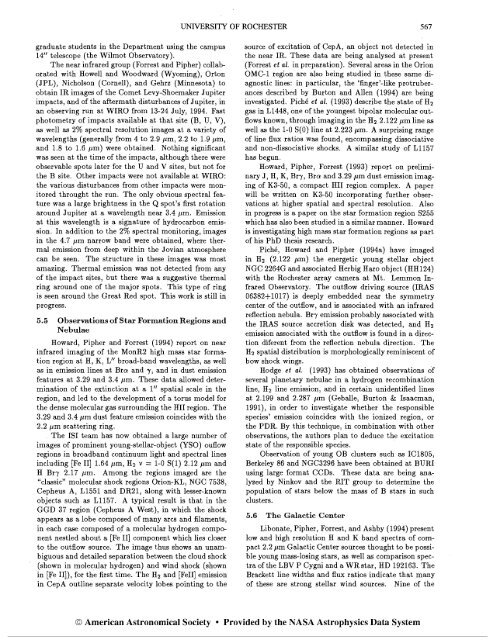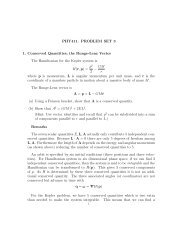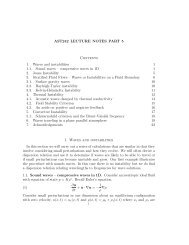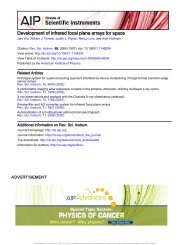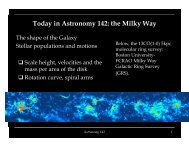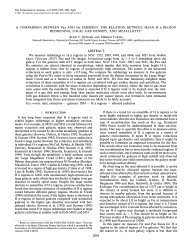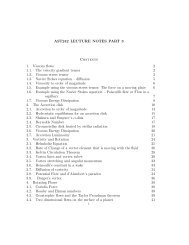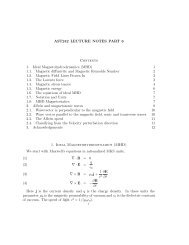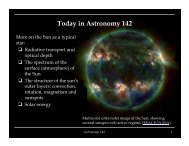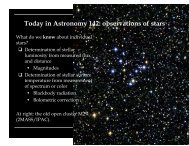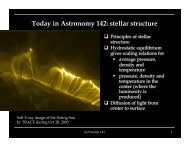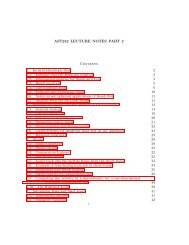University of Rochester C. E. K. Mees Observatory - Astro Pas ...
University of Rochester C. E. K. Mees Observatory - Astro Pas ...
University of Rochester C. E. K. Mees Observatory - Astro Pas ...
You also want an ePaper? Increase the reach of your titles
YUMPU automatically turns print PDFs into web optimized ePapers that Google loves.
UNIVERSITY OF ROCHESTER 567graduate students in the Department using the campus14" telescope (the Wilmot <strong>Observatory</strong>).The near infrared group (Forrest and Pipher) collaboratedwith Howell and Woodward (Wyoming), Orton(JPL), Nicholson (Cornell), and Gehrz (Minnesota) toobtain IR images <strong>of</strong> the Comet Levy-Shoemaker Jupiterimpacts, and <strong>of</strong> the aftermath disturbances <strong>of</strong> Jupiter, inan observing run at WIRO from 13-24 July, 1994. Fastphotometry <strong>of</strong> impacts available at that site (B, U, V),as well as 2% spectral resolution images at a variety <strong>of</strong>wavelengths (generally from 4 to 2.9 pm, 2.2 to 1.9 pm,and 1.8 to 1.6 pm) were obtained. Nothing significantwas seen at the time <strong>of</strong> the impacts, although there wereobservable spots later for the U and V sites, but not forthe B site. Other impacts were not available at WIRO:the various disturbances from other impacts were monitoredthrought the run. The only obvious spectral featurewas a large brightness in the Q spot's first rotationaround Jupiter at a wavelength near 3.4 pm. Emissionat this wavelength is a signature <strong>of</strong> hydrocarbon emission.In addition to the 2% spectral monitoring, imagesin the 4.7 pm narrow band were obtained, where thermalemission from deep within the Jovian atmospherecan be seen. The structure in these images was mostamazing. Thermal emission was not detected from any<strong>of</strong> the impact sites, but there was a suggestive thermalring around one <strong>of</strong> the major spots. This type <strong>of</strong> ringis seen around the Great Red spot. This work is still inprogress.5.5 Observations <strong>of</strong> Star Formation Regions andNebulaeHoward, Pipher and Forrest (1994) report on nearinfrared imaging <strong>of</strong> the MonR2 high mass star formationregion at H, K, L" broad-band wavelengths, as wellas in emission lines at Bra and 7, and in dust emissionfeatures at 3.29 and 3.4 pm. These data allowed determination<strong>of</strong> the extinction at a 1" spatial scale in theregion, and led to the development <strong>of</strong> a torus model forthe dense molecular gas surrounding the HI1 region. The3.29 and 3.4 pm dust feature emission coincides with the2.2 pm scattering ring.The IS1 team has now obtained a large number <strong>of</strong>images <strong>of</strong> prominent young-stellar-object (YSO) ouflowregions in broadband continuum light and spectral linesincluding [Fe 111 1.64 pm, H2 v = 1-0 S(l) 2.12 pm andH Bry 2.17 pm. Among the regions imaged are the"classic" molecular shock regions Orion-KL, NGC 7538,Cepheus A, L1551 and DR21, along with lesser-knownobjects such as L1157. A typical result is that in theGGD 37 region (Cepheus A West), in which the shockappears as a lobe composed <strong>of</strong> many arcs and filaments,in each case composed <strong>of</strong> a molecular hydrogen componentnestled about a [Fe 111 component which lies closerto the outflow source. The image thus shows an unambiguousand detailed separation between the cloud shock(shown in molecular hydrogen) and wind shock (shownin [Fe II]), for the first time. The Hz and [FeII] emissionin CepA outline separate velocity lobes pointing to thesource <strong>of</strong> excitation <strong>of</strong> CepA, an object not detected inthe near IR. These data are being analysed at present(Forrest et al. in preparation). Several areas in the OrionOMC-1 region are also being studied in these same diagnosticlines: in particular, the 'finger'-like protruberancesdescribed by Burton and Allen (1994) are beinginvestigated. PichC et al. (1993) describe the state <strong>of</strong> Hagas in L1448, one <strong>of</strong> the youngest bipolar molecular outflowsknown, through imaging in the Hz 2.122 pm line aswell as the 1-0 S(0) line at 2.223 pm. A surprising range<strong>of</strong> line flux ratios was found, encompassing dissociativeand non-dissociative shocks. A similar study <strong>of</strong> L1157has begun.Howard, Pipher, Forrest (1993) report on preliminaryJ, H, K, Bry, Bra and 3.29 pm dust emission imaging<strong>of</strong> K3-50, a compact HI1 region complex. A paperwill be written on K3-50 incorporating further observationsat higher spatial and spectral resolution. Alsoin progress is a paper on the star formation region S255which has also been studied in a similar manner. Howardis investigating high mass star formation regions as part<strong>of</strong> his PhD thesis research.PichC, Howard and Pipher (1994a) have imagedin Hz (2.122 pm) the energetic young stellar objectNGC 2264G and associated Herbig Haro object (HH124)with the <strong>Rochester</strong> array camera at Mt. Lemmon Infrared<strong>Observatory</strong>. The outflow driving source (IRAS06382+1017) is deeply embedded near the symmetrycenter <strong>of</strong> the outflow, and is associated with an infraredreflection nebula. Bry emission probably associated withthe IRAS source accretion disk was detected, and Hzemission associated with the outflow is found in a directiondiferent from the reflection nebula direction. TheHz spatial distribution is morphologically reminiscent <strong>of</strong>bow shock wings.Hodge et al. (1993) has obtained observations <strong>of</strong>several planetary nebulae in a hydrogen recombinationline, Hz line emission, and in certain unidentified linesat 2.199 and 2.287 pm (Geballe, Burton & Isaacman,1991), in order to investigate whether the responsiblespecies' emission coincides with the ionized region, orthe PDR. By this technique, in combination with otherobservations, the authors plan to deduce the excitationstate <strong>of</strong> the responsible species.Observation <strong>of</strong> young OB clusters such as IC1805,Berkeley 86 and NGC3296 have been obtained at BUR1using large format CCDs. These data are being analyzedby Ninkov and the RIT group to determine thepopulation <strong>of</strong> stars below the mass <strong>of</strong> B stars in suchclusters.5.6 The Galactic CenterLibonate, Pipher, Forrest, and Ashby (1994) presentlow and high resolution H and K band spectra <strong>of</strong> compact2.2 pm Galactic Center sources thought to be possibleyoung mass-losing stars, as well as comparison spectra<strong>of</strong> the LBV P Cygni and a WR star, HD 192163. TheBrackett line widths and flux ratios indicate that many<strong>of</strong> these are strong stellar wind sources. Nine <strong>of</strong> theO American <strong>Astro</strong>nomical SocietyProvided by the NASA <strong>Astro</strong>physics Data System


